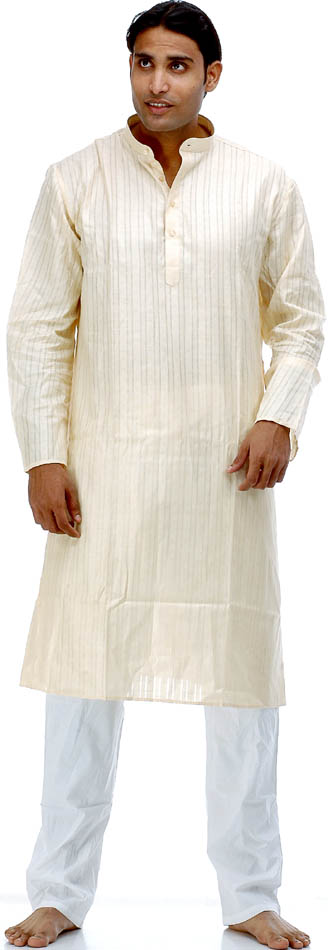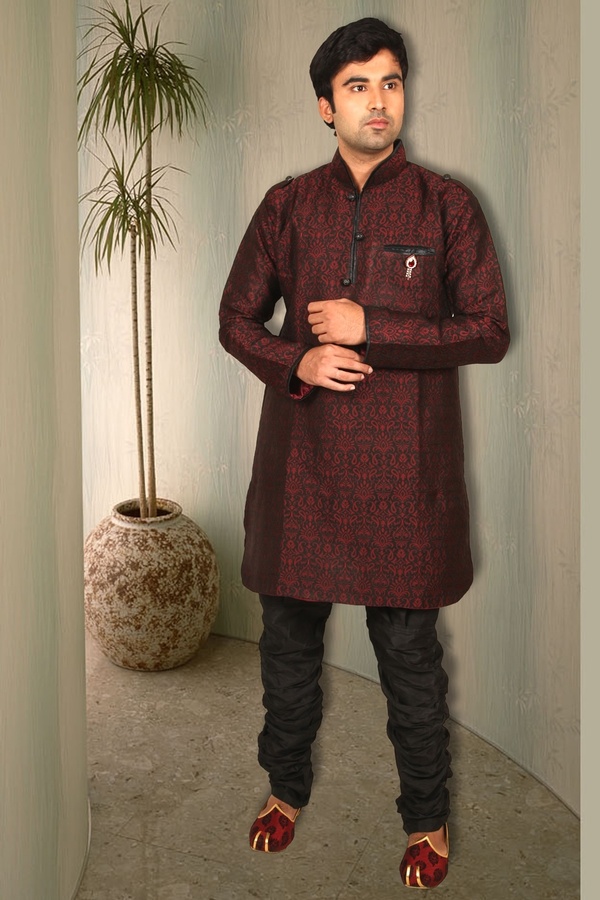Kurta Pajama Style Biography
Source link (google.com.pk)
What makes the Indian couture so unique is the fact that you will find each and every state of the country having its own distinct traditional clothing for men and women. For instance, the salwaar kameez is the ethnic attire of women in Punjab; the Mekhala Chadar is worn by Assamese women, and so on. However, all types of Indian clothing look very elegant and Indians wear them with a lot of pride. The festivities and other special occasions are the time when you can see maximum Indians donning their ethnic garb, be it sari, kurta pajama or dhoti. A sari is long strip of colorful multi-patterned cloth seductively wrapped around the body, teemed with a blouse! It's the traditional dress for the women folk in India and there are many styles in which you can drape it. The blouse worn with sari is also called the choli or ravika. The salwaar kameez, on the other hand, is the most ubiquitous of all traditional women attires in India. Due to its popularity in the Punjab region, it is sometimes also called the Punjabi suit. The Indian men's traditional attire consists of the kurta and pajama, dhoti, lungi and other dresses. Worn on both formal and informal occasions, kurta and pajama are quite popular dress of Indian men. The kurta is like a loose long shirt almost reaching the knees, whereas the Pyjama is a lightweight drawstring trouser. The men's dhoti is a rectangular piece of unstitched cloth about five yards long, wrapped about the waist and the legs and knotted at the waist. It is known by different names like Laacha in Punjabi, Mundu in Malayalam, Dhuti in Bangla, etc.Traditional Indian clothing has come into prominence once again. Well, if you notice the trends in fashion industry, you'll realize that modern fashion has aped the styling and designing of the bygone eras, the period of royalty, when Maharajas and Ranis used to spend extravagantly on their clothing. Whatever the royals chose to go in for was reminiscent of splendor and luxury. The creative fashion designers of today are in a lookout for ethnic designs that take us close to our cultural roots and remind us of the glorious past. Well, in this section, we will provide you with information on the different kinds of traditional clothing in India, so read on…Dhoti .Dhoti kurta is the traditional Indian clothing of men. Unlike other dresses, it is an unstitched piece of cloth usually 5 yards long that is tied around the waist and legs. The knot is tied at the waist. Dhoti is known by different names at different places such as Laacha in Punjabi, dhuti in Bangla. Kurta is a term used to refer to a long loose shirt, the length of which falls below or may be just above the knees of the wearer. In the olden times, it was primarily worn by men, but today, it has become a unisex dress that both men and women can wear. Indian Salwar KameezSalwar kameez is the traditional Indian clothing for women. Due to its high popularity in the region of Punjab, shalwar kameez is commonly referred to as Punjabi suit. The fashion of Shalwar Kameez in India is not new. Since the past many few centuries, women have been wearing this wonderful attire. Indian Sari.Sari is one of the most wonderful dresses worn by Indian women. Infact, when one thinks of a typical Indian woman, the first thing that strikes the mind is a woman clad in sari, who is wearing the solah shringar including bindi, chudi, kajal etc. Sherwani is a long coat resembling achkan in styling. It is buttoned upto the collar and lengthwise it is usually below the knee. It adds to the charm and grace of men, especially the taller ones. Indian men spend lavishly on buying the sherwani suit for the special occasion of their wedding. In India, one can spot many men wearing turban. Well, turban is tied not for the sake of fashion, but because it has a lot of significance in the lives of Indians. The hair turban is a headdress that basically consists of a long piece of unstitched cloth, which is wrapped around the head.The kurta pajama is the male counterpart of the feminine salwar kameez and the preferred mode of dressing for the Indian male. The reasons for this are not too far to seek. Highly comfortable and eminently suited to all climatic conditions, its use is widespread throughout the Indian subcontinent.
The sherwani (a long coat-like garment), is named after the Sherwani family, a large Muslim clan of mixed Arab and Pashtoon descent, now settled mainly around the Aligarh (UP) and Malerkotla (Punjab) areas in India. It is the national dress of Pakistan, one which is universally accepted there, not specifically belonging to any one of its many provinces.
Kurta Pajama Style Kurta Pajama For Men Designs with Nehru Jacket Punjabi Style Simple Sikh Designs 2014 with Jacket Photos Images
Kurta Pajama Style Kurta Pajama For Men Designs with Nehru Jacket Punjabi Style Simple Sikh Designs 2014 with Jacket Photos Images
Kurta Pajama Style Kurta Pajama For Men Designs with Nehru Jacket Punjabi Style Simple Sikh Designs 2014 with Jacket Photos Images
Kurta Pajama Style Kurta Pajama For Men Designs with Nehru Jacket Punjabi Style Simple Sikh Designs 2014 with Jacket Photos Images
Kurta Pajama Style Kurta Pajama For Men Designs with Nehru Jacket Punjabi Style Simple Sikh Designs 2014 with Jacket Photos Images
Kurta Pajama Style Kurta Pajama For Men Designs with Nehru Jacket Punjabi Style Simple Sikh Designs 2014 with Jacket Photos Images
Kurta Pajama Style Kurta Pajama For Men Designs with Nehru Jacket Punjabi Style Simple Sikh Designs 2014 with Jacket Photos Images
Kurta Pajama Style Kurta Pajama For Men Designs with Nehru Jacket Punjabi Style Simple Sikh Designs 2014 with Jacket Photos Images
Kurta Pajama Style Kurta Pajama For Men Designs with Nehru Jacket Punjabi Style Simple Sikh Designs 2014 with Jacket Photos Images
Kurta Pajama Style Kurta Pajama For Men Designs with Nehru Jacket Punjabi Style Simple Sikh Designs 2014 with Jacket Photos Images
Kurta Pajama Style Kurta Pajama For Men Designs with Nehru Jacket Punjabi Style Simple Sikh Designs 2014 with Jacket Photos Images










No comments:
Post a Comment